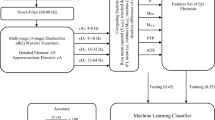Summary
EEG data from 30 channels were recorded during movement and reading tasks and analyzed in the three frequency bands 6– 8 Hz, 8–10 Hz and 10–12 Hz. For each frequency band, the ERD (event-related desynchronization) was quantified and displayed in the form of time courses and maps. The results show that the ERD pattern varies with the frequency component analyzed. In general, upper alpha components (10–12 Hz) demonstrate a short-lasting, task-specific and localized ERD; the ERD of lower alpha components is long-lasting (> 1 sec) and widespread. The ERD can be interpreted as a sign of cortical activation, whereby desynchronization of upper alpha components may reflect more task-specific processes, and desynchronization of middle and lower alpha components may be related to the level of expectancy and attention.
Similar content being viewed by others
References
Chatrian, G.E., Petersen, M.C. and Lazarte, J.A. The blocking of the rolandic wicket rhythm and some central changes related to movement. Electroenceph. Clin. Neurophysiol., 1959, 11:497–510.
Jasper, H.H. and Penfield, W. Electrocorticograms in man: Effect of the voluntary movement upon the electrical activity of the precentral gyrus. Arch. Psychia. Z. Neurol. 1949, 183:163–174.
Klimesch, W. Struktur und Aktivierung des Gedaechtnisses: Das Vernetzungsmodell: Grundlagen und Elemente einer uebergreifenden Theorie. Huber, Toronto and Bern, 1988.
Klimesch, W., Pfurtscheller, G. and Mohl, W. ERD mapping and long-term memory: The temporal and topographical pattern of cortical activation. In: Pfurtscheller, G. and Lopes da Silva, F.H. (Eds.), Functional Brain Imaging, Huber, Toronto and Bern, 1988: 131–141.
Klimesch, W., Pfurtscheller, G., Mohl, W. and Schimke, H. Event-related desynchronization, ERD mapping and hemispheric differences for words and numbers. Int. J. Psychophysiol. 1989a, in press.
Klimesch, W., Pfurtscheller, G., Schimke, H. and Mohl, W. Pre-and poststimulus processes in semantic classification as measured by event-related desynchronization. 1989b, Manuscript in preparation.
Mulholland, T. The concept of attention and the electroencephalographic alpha rhythm. In: Evans, C.R. and Mulholland, T.B. (Eds.), Attention in Neurophysiology, Butterworth, London, 1969: 100–127.
Pfurtscheller, G. and Aranibar, A. Event-related cortical desynchronization detected by power measurements of scalp EEG. Electroenceph. Clin. Neurophysiol., 1977, 42:817–826.
Pfurtscheller, G. and Aranibar, A. Evaluation of event- related desynchronization (ERD) preceding and following self-paced movement. Electroenceph. Clin. Neurophysiol., 1979, 46:138–146.
Pfurtscheller, G., Steffan, J. and Maresch, H. ERD-mapping and functional topography-temporal and spatial aspects. In: Pfurtscheller, G. and Lopes da Silva, F.H. (Eds.), Functional Brain Imaging, Huber, Toronto and Bern, 1988: 117–130.
Pfurtscheller, G. and Berghold, A. Pattern of cortical activation during planning of voluntary movement. Electroenceph. Clin. Neurophysiol., 1989, 72:250–258.
Roland, P.E., Eriksson, L., Stone-Elander, S. and Widen, L. Does mental activity change the oxidative metabolism of the brain? J. Neurosci., 1987, 7(8):2373–2389.
Roland, P.E. and Widen, L. Quantitative measurements of brain metabolism during physiological stimulation. In: Pfurtscheller, G. and Lopes da Silva, F.H. (Eds.), Functional Brain Imaging, Huber, Toronto and Bern, 1988:213–228.
Sergeant, J., Geuze, R. and Van Winsum, W. Event-related desynchronization and P300. Psychophysiology, 1987, 24:272–277.
Steriade, M. and Llinas, R.R. The functional states of the thalamus and the associated neuronal interplay. Physiol. Rev., 1988, 68(3): 649–742.
Williamson, S.J. and Kaufman, L. Advances in neuromagnetic instrumentation and studies of spontaneous brain activity. Proc. Topographic EEG Analysis and Brain Mapping, Valle d'Aosta, Italy, Sept. 7–10, 1989.
Author information
Authors and Affiliations
Additional information
Acknowledgement: This study was supported by grants from the Ministry of Science and Research and the "Fonds zur Foerderung der wissenschaftlichen Forschung", Projects S4902 and S4905 MED, in Austria and was done in collaboration with Dr. W. Klimesch of the Dept. of Psychology, University of Salzburg.
Rights and permissions
About this article
Cite this article
Pfurtscheller, G. Spatiotemporal analysis of alpha frequency components with the ERD technique. Brain Topogr 2, 3–8 (1989). https://doi.org/10.1007/BF01128838
Accepted:
Issue Date:
DOI: https://doi.org/10.1007/BF01128838




